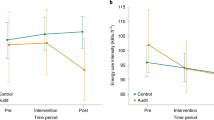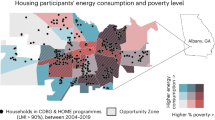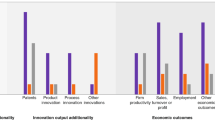Abstract
Information programs are promising strategies to encourage investments in energy efficiency in commercial buildings. However, the realized effectiveness of these programs has not yet been estimated on a large scale. Here we take advantage of a large sample of monthly electricity consumption data for 178,777 commercial buildings in Los Angeles to analyse energy savings and emissions reductions from three major programs designed to encourage efficiency: the US Department of Energy’s Better Buildings Challenge, the US Environmental Protection Agency’s Energy Star program and the US Green Building Council’s Leadership in Energy and Environmental Design (LEED) program. Using matching techniques, we find energy savings that range from 18% to 30%, depending on the program. These savings represent a reduction of 210 million kilowatt-hours or 145 kilotons of CO2 equivalent emissions per year. However, we also find that these programs do not substantially reduce emissions in small and medium sized buildings, which represent about two-thirds of commercial sector building emissions.
This is a preview of subscription content, access via your institution
Access options
Access Nature and 54 other Nature Portfolio journals
Get Nature+, our best-value online-access subscription
$29.99 / 30 days
cancel any time
Subscribe to this journal
Receive 12 digital issues and online access to articles
$119.00 per year
only $9.92 per issue
Buy this article
- Purchase on Springer Link
- Instant access to full article PDF
Prices may be subject to local taxes which are calculated during checkout


Similar content being viewed by others
References
IPCC Climate Change 2014: Mitigation of Climate Change (eds Edenhofer, O. et al.) (Cambridge Univ. Press, 2014).
Buildings and Climate Change: Summary for Decision-Makers DTI/1240/PA (UNEP, 2009).
National Research Council Real Prospects for Energy Efficiency in the United States (National Academies, 2010).
Energy Star Facts and Stats 2015 (EPA, 2015); www.energystar.gov/buildings/about-us/facts-and-stats
Green Building Facts (USGBC, 2015); http://stg.usgbc.org/articles/green-building-facts
Better Buildings Challenge Overview (DOE, 2016); http://betterbuildingssolutioncenter.energy.gov/sites/default/files/attachments/Better%20Buildings%20Challenge%20Overview.pdf
Better Buildings 2012 Progress Report (DOE, 2012); https://www4.eere.energy.gov/challenge/sites/default/files/uploaded-files/BB_ProgressRpt_508_121112.pdf
Delmas, M. A., Fischlein, M. & Asensio, O. I. Information strategies and energy conservation behavior: a meta-analysis of experimental studies from 1975–2012. Energy Policy 61, 729–739 (2013).
Potoski, M. & Prakash, A. Green clubs: collective action and voluntary environmental programs. Annu. Rev. Polit. Sci. 16, 399–419 (2013).
Eichholtz, P., Kok, N. & Quigley, J. M. The economics of green building. Rev. Econ. Stat. 95, 50–63 (2013).
Eichholtz, P., Kok, N. & Quigley, J. M. Doing well by doing good? Green office buildings. Am. Econ. Rev. 100, 2492–2509 (2010).
Fuerst, F. & McAllister, P. Green noise or green value? Measuring the effects of environmental certification on office values. Real Estate Econ. 39, 45–69 (2011).
Kahn, M. E. & Kok, N. The capitalization of green labels in the California housing market. Reg. Sci. Urban Econ. 47, 25–34 (2014).
Mathew, P. A. et al. Big-data for building energy performance: lessons from assembling a very large national database of building energy use. Appl. Energy 140, 85–93 (2015).
Pincetl, S., Graham, R., Murphy, S. & Sivaraman, D. Analysis of high-resolution utility data for understanding energy use in urban systems: the case of Los Angeles, California. J. Ind. Ecol. 20, 166–178 (2016).
Heckman, J. J., Ichimura, H., Smith, J. & Todd, P. Sources of selection bias in evaluating social programs: an interpretation of conventional measures and evidence on the effectiveness of matching as a program evaluation method. Proc. Natl Acad. Sci. USA 93, 13416–13420 (1996).
Allcott, H. & Greenstone, M. Is there an energy efficiency gap? J. Econ. Perspect. 26, 3–28 (2012).
Allcott, H. & Mullainathan, S. Behavior and energy policy. Science 327, 1204–1205 (2010).
Asensio, O. I. & Delmas, M. A. Nonprice incentives and energy conservation. Proc. Natl Acad. Sci. USA 112, E510–E515 (2015).
Boomhower, J. & Davis, L. A credible approach for measuring inframarginal participation in energy efficiency programs. J. Public Econ. 113, 67–79 (2014).
Ito, K. Do consumers respond to marginal or average price? Evidence from nonlinear electricity pricing. Am. Econ. Rev. 104, 537–563 (2014).
Imai, K., King, G. & Stuart, E. A. Misunderstandings between experimentalists and observationalists about causal inference. J. R. Stat. Soc. A 171, 481–502 (2008).
Keane, M. P. A structural perspective on the experimentalist school. J. Econ. Perspect. 24, 47–58 (2010).
Ho, D. E., Imai, K., King, G. & Stuart, E. Matching as nonparametric preprocessing for reducing model dependence in parametric causal inference. Polit. Anal. 15, 199–236 (2007).
Imbens, G. W. & Wooldridge, J. M. Recent developments in the econometrics of program evaluation. J. Econ. Lit. 47, 5–86 (2009).
Sekhon, J. S. Opiates for the matches: matching methods for causal inference. Annu. Rev. Polit. Sci. 12, 487–508 (2009).
Pincetl, S. Los Angeles Energy Atlas (California Center for Sustainable Communities, 2016); www.energyatlas.ucla.edu
Los Angeles Recognized for Leadership in Energy Efficiency, Better Buildings Challenge (DOE, 2014); http://energy.gov/articles/los-angeles-recognized-leadership-energy-efficiency-better-buildings-challenge
Crawley, D. B., Hand, J. W., Kummert, M. & Griffith, B. T. Contrasting the capabilities of building energy performance simulation programs. Build. Environ. 43, 661–673 (2008).
Deng, Y., Li, Z. & Quigley, J. M. Economic returns to energy-efficient investments in the housing market: evidence from Singapore. Reg. Sci. Urban Econ. 42, 506–515 (2012).
Andam, K. S., Ferraro, P. J., Pfaff, A. & Sanchez-Azofeifa, G. A. Measuring the effectiveness of protected area networks in reducing deforestation. Proc. Natl Acad. Sci. USA 105, 16089–16094 (2008).
Noah, M. A. et al. Referral to an extracorporeal membrane oxygenation center and mortality among patients with severe 2009 influenza A(H1N1). J. Am. Med. Assoc. 306, 1659–1668 (2011).
Brady, H. E. & McNulty, J. E. Turning out to vote: the costs of finding and getting to the polling place. Am. Polit. Sci. Rev. 105, 115–134 (2011).
Diamond, A. & Sekhon, J. S. Genetic matching for estimating causal effects: a general multivariate matching method for achieving balance in observational studies. Rev. Econ. Stat. 95, 932–945 (2013).
Delmas, M. A. & Pekovic, S. Resource efficiency strategies and market conditions. Long Range Plan. 48, 80–94 (2015).
Arimura, T. H., Li, S., Newell, R. G. & Palmer, K. Cost-effectiveness of electricity energy efficiency programs. Energy J. 33, 63–99 (2012).
Loughran, D. S. & Kulick, J. Demand-side management and energy efficiency in the United States. Energy J. 25, 19–43 (2004).
Auffhammer, M., Blumstein, C. & Fowlie, M. Demand-side management and energy efficiency revisited. Energy J. 29, 91–104 (2008).
Anderson, S. T. & Newell, R. G. Information programs for technology adoption: the case of energy-efficiency audits. Resour. Energy Econ. 26, 27–50 (2004).
Jaffe, A. B. & Stavins, R. N. The energy-efficiency gap what does it mean? Energy Policy 22, 804–810 (1994).
Gillingham, K., Newell, R. G. & Palmer, K. Energy efficiency economics and policy. Annu. Rev. Resour. Econ. 1, 597–620 (2009).
Dietz, T. Narrowing the US energy efficiency gap. Proc. Natl Acad. Sci. USA 107, 16007–16008 (2010).
Matisoff, D. C., Noonan, D. S. & Flowers, M. E. Policy monitor—green buildings: economics and policies. Rev. Environ. Econ. Policy 10, 329–346 (2016).
DeCanio, S. J. Barriers within firms to energy-efficient investments. Energy Policy 21, 906–914 (1993).
Blass, V., Corbett, C. J., Delmas, M. A. & Muthulingam, S. Top management involvement and the adoption of energy efficiency practices: evidence from small and medium-sized manufacturing firms in the US. Energy 65, 560–571 (2014).
Muthulingam, S., Corbett, C. J., Benartzi, S. & Oppenheim, B. Energy efficiency in small and medium-sized manufacturing firms: order effects and the adoption of process improvement recommendations. Manuf. Serv. Oper. Manage. 15, 596–615 (2013).
Sekhon, J. S. Multivariate and propensity score matching software with automated balance optimization: the matching package for R. J. Stat. Softw. 42, 1–52 (2011).
Rosenbaum, P. R. & Rubin, D. B. The central role of the propensity score in observational studies for causal effects. Biometrika 70, 41–55 (1983).
Abadie, A. & Imbens, G. W. Bias-corrected matching estimators for average treatment effects. J. Bus. Econ. Stat. 29, 1–11 (2011).
Caliendo, M. & Kopeinig, S. Some practical guidance for the implementation of propensity score matching. J. Econ. Surv. 22, 31–72 (2008).
Asensio, O. I. & Delmas, M. A. The dynamics of behavior change: evidence from energy conservation. J. Econ. Behav. Organ. 126, 196–212 (2016).
Rosenbaum, P. R. Observational Studies (Springer, 2002).
Kahn, M. E., Kok, N. & Quigley, J. M. Carbon emissions from the commercial buildings sector: the role of climate, quality and incentives. J. Public Econ. 113, 1–12 (2014).
Asensio, O. Matching code for buildings (2017); http://dx.doi.org/10.6084/m9.figshare.4625119
Acknowledgements
This study would not be possible without S. Pincetl and her Energy Atlas team at the California Center for Sustainable Communities. For collaboration and access to program data, we thank D. Hodgins and J. Gould at the Los Angeles Better Buildings Challenge and B. Stapleton at the Los Angeles Cleantech Incubator. We also thank T. Vir Singh for high performance computing support on the Hoffman2 cluster. For helpful comments and suggestions, we thank H. Godwin, P. Kareiva, B. Lawrence, J. Lim, S. Neff, S. Muthulingam, S. Pincetl, D. Rajagopal, J. Sekhon and M. Tikoff Vargas. This research was supported by funding from the UCLA Rosalinde and Arthur Gilbert Program in Real Estate, Finance and Urban Economics; the Easton Technology Leadership Program at the UCLA Anderson School of Management; the University of California Center for Energy and Environmental Economics at Berkeley; the UCLA Institute for Digital Research and Education (IDRE) Postdoctoral Fellowship, and the Pritzker Distinguished Chair in Environment and Sustainability.
Author information
Authors and Affiliations
Contributions
O.I.A. and M.A.D. contributed equally to this study.
Corresponding author
Ethics declarations
Competing interests
The authors declare no competing financial interests.
Supplementary information
Supplementary Information
Supplementary Figures 1 and 2, Supplementary Tables 1–11, Supplementary Notes 1–3, Supplementary References. (PDF 1130 kb)
Rights and permissions
About this article
Cite this article
Asensio, O., Delmas, M. The effectiveness of US energy efficiency building labels. Nat Energy 2, 17033 (2017). https://doi.org/10.1038/nenergy.2017.33
Received:
Accepted:
Published:
DOI: https://doi.org/10.1038/nenergy.2017.33
This article is cited by
-
Housing policies and energy efficiency spillovers in low and moderate income communities
Nature Sustainability (2024)
-
Revisiting the promise of carbon labelling
Nature Climate Change (2022)
-
When artificial intelligence meets building energy efficiency, a review focusing on zero energy building
Artificial Intelligence Review (2021)
-
Correcting consumer misperception
Nature Energy (2019)
-
Energy efficiency: Building labels lead to savings
Nature Energy (2017)



